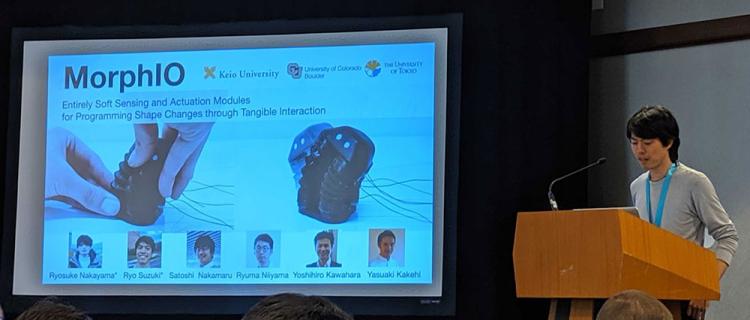ATLAS makes its mark at DIS'19
Researchers from ATLAS Institute's THING, ACME and Unstable Design labs took home "Best Paper" and "Best Pictorial" awards at the ACM conference on Designing Interactive Systems (DIS '19), held in San Diego, June 23-28. ATLAS faculty and students also contributed four research presentations, including one by undergraduate researcher Jolie Klefeker, an engineering student majoring in Technology, Arts & Media who was previously chosen as a Grace Hopper Research Scholar.
DIS is an international and interdisciplinary conference encompassing issues related to the design and deployment of interactive systems, where designers, artists, theorists, psychologists, user experience researchers, systems engineers and many more come together to debate and shape the future of interaction systems research, design and practice.

ATLAS research presented at DIS '19:
- "MorphIO: Entirely Soft Sensing and Actuation Modules for Programming Shape Changes through Tangible Interaction," authored by Ryo Suzuki and researchers from Keio University and The University of Tokyo in Japan, won a DIS '19 "Best Paper" award. Suzuki, an ATLAS affiliated PhD student, presented the research during the conference's Shape Changes Interfaces track. MorphIO addresses problems that researchers face when trying to program movements in soft materials: Instead of transferring compiled code from a digital screen to objects, MorphIO’s hardware enables users to program behaviors using motion-capture data gathered from physical movement and interactions. It also allows users to construct various shapes and synthesize multiple recorded motions to achieve complex movements, such as bending, gripping and walking.
- ATLAS PhD students Peter Gyory and Clement Zheng's game HOT SWAP was showcased during the Provocations and Work-in-Progress session at DIS '19, and Gyory also presented the research during the conference's poster and demo reception. One of the most original aspects of Zheng and Gyory's game, which received the coveted alt.ctrl.GDC award at this year's Game Developers Conference in San Francisco, is the use of a wide range of game controllers which must be switched to perform different functions within the game.
- Research from "Envisioning Reflective, Relaxing, and Restorative Design with ASMR," a work-in-progress paper authored by Josephine Klefeker and Laura Devendorf, was presented by lead author, Klefeker, an undergraduate TAM major and researcher in the Unstable Design Lab, during the Works-in-Progress track of DIS '19. The research was inspired by Autonomous Sensory Meridian Response (ASMR) media, where gentle repetitive sounds, such as listening to a whispering voice or the sounds of pages turning, elicit, for some, relaxing tingling sensations at the back of the skull that move down the back of the neck and upper spine. The research covered five research subjects who used a sonic toolkits to make recordings inspired by ASMR media. The work looks at whether the aesthetics of ASMR media can inspire the design of technology that provokes reflective thoughts and relaxation.
- “Sensing Kirigami,” authored by Clement Zheng, HyunJoo Oh, Laura Devendorf, and Ellen Yi-Luen Do, won the "Best Pictorial" award at DIS '19. Lead author, Zheng, an ATLAS PhD student, presented the research during the DIS '19 Deformable and Novel Materials track. This inquiry into carbon-coated paper and kirigami structures involved investigating two variations of the paper and their electrical, haptic and visual aspects when shaped into 3D forms through cutting, folding and bending. Three applications that showcase the possibilities of this material for tangible interaction design were proposed. Researchers also used a pictorial format of working design schematics so others could explore on their own.


